Ready to plant some gorgeous containers? Start by studying these ten plant combination ideas for container gardens and learning what makes them such good pairings. From there, copy the look or change it up using our tips for what makes each container recipe so effective. Prepare to be inspired!
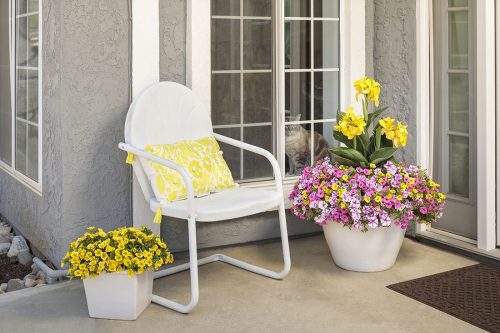
Growing Conditions: Full sun to mostly sunny, average moisture, weekly feeding with water soluble fertilizer.
Plant List:
- Toucan® Yellow canna lily
- Supertunia® Lovie Dovie™ petunia
- Supertunia Mini Vista® Hot Pink petunia
- Superbells® Yellow calibrachoa
Why it works:
Perfectly paired pinks and yellows, along with a preference for sunny spaces and moist soil makes these blooms flourish together. Solid pink Supertunia Mini Vista® Hot Pink flowers complement the pink and white striped Supertunia® Lovie Dovie™ blooms. Yellow is repeated in each element of this scene, tying all three objects together into one cohesive look.
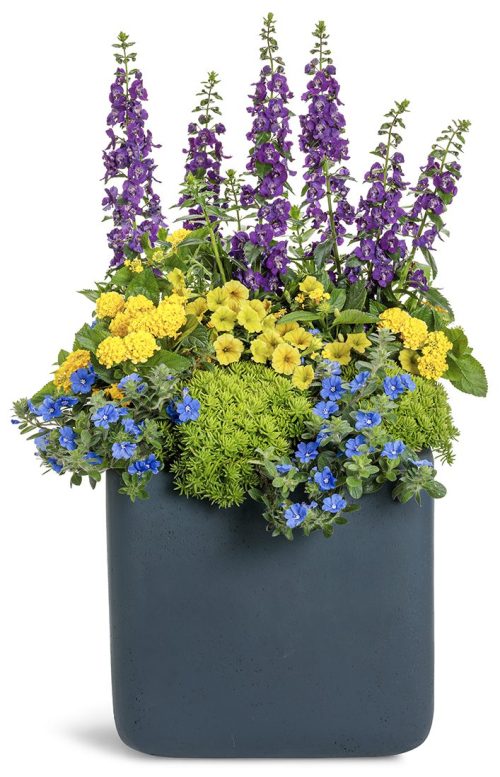
Growing Conditions: Full sun, average moisture, bi-weekly feeding with water soluble fertilizer.
Plant List:
- Angelface® Blue Angelonia
- Blue My Mind® Evolvulus
- Luscious® Royale Lemon Tart™ lantana
- Supertunia Mini Vista® Yellow petunia
- Lemon Coral® sedum
Why it works:
Five sun-loving annuals with a beautiful mix of textures and flower shapes in a classic thriller-filler-spiller design make this recipe work. Average moisture, meaning watering before the soil dries out completely between waterings, and bi-weekly feeding is all these particular annuals need to thrive. A limited color palette with two main colors – blue/purple and yellow – planted in a sleek container, give this recipe a more modern look. Prefer warmer colors? Simply choose other colors in the Angelface®, Luscious® and Supertunia Mini Vista® series.
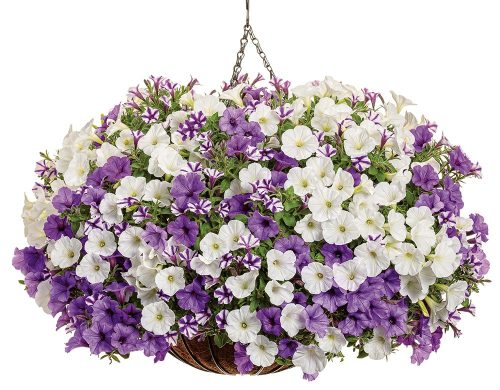
Growing Conditions: Full sun to part sun, average moisture, weekly feeding with water soluble fertilizer.
Plant List:
- Supertunia Mini Vista® White petunia
- Supertunia Mini Vista® Indigo petunia
- Supertunia Mini Vista® Violet Star petunia
Why it works:
One of the simplest, most effective ways to ensure a perfect pairing is to plant three different varieties of the same type of plant together. Doing so guarantees they will all flourish equally under the same growing conditions and usually means they will all share the same vigor and habit. Here, two solid-colored Supertunia Mini Vista® petunias are paired with one striped variety in the same series, with all three colors complementing one another with precision.
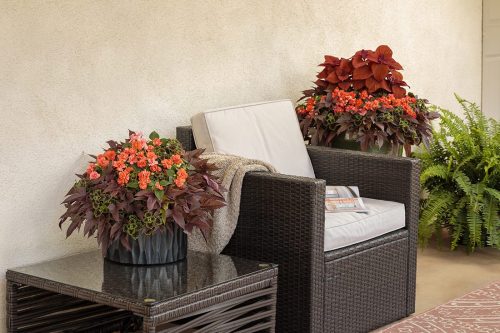
Growing Conditions: Part shade to full shade, moist soil, weekly to bi-weekly feeding with water soluble fertilizer.
Plant List:
- ColorBlaze® Sedona Sunset® coleus
- Rockapulco® Tropical Shades double impatiens
- Sweet Caroline Red Hawk™ sweet potato vine
- ColorBlaze® Chocolate Drop coleus
Why it works:
Two similar container recipes surround this cozy seating nook, the taller urn carrying the addition of a taller thriller plant – ColorBlaze® Sedona Sunset® coleus. Perfect for an east-facing space or a spot with open shade all day, these shade-tolerant plants will all thrive with consistent moisture. A few times per season, pinch the stems of the sweet potato vine and trailing coleus to keep them in check. Warm orange and bronze tones help to create a grounded, relaxing feeling in this quiet space.
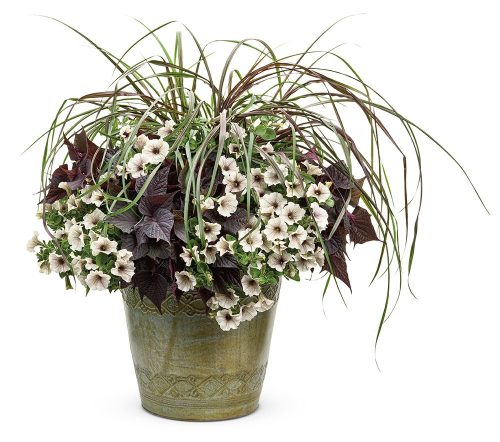
Growing Conditions: Full sun, average to moist soil, weekly to bi-weekly feeding with water soluble fertilizer.
Plant List:
- Purple fountain grass
- Supertunia® Latte™ petunia
- Sweet Caroline Bewitched After Midnight™ sweet potato vine
Why it works:
That little black dress that goes with everything? Here’s the container recipe equivalent! It’s a sophisticated look for front entrances, more formal garden beds and patios. Notice how the dark throat of Supertunia® Latte™ is perfectly complemented by its two dark foliage companions. All three elements will thrive in full sun with average moisture earlier in the season, but you’ll need to water a little more once the grass hits its growth spurt when summer’s heat settles in.
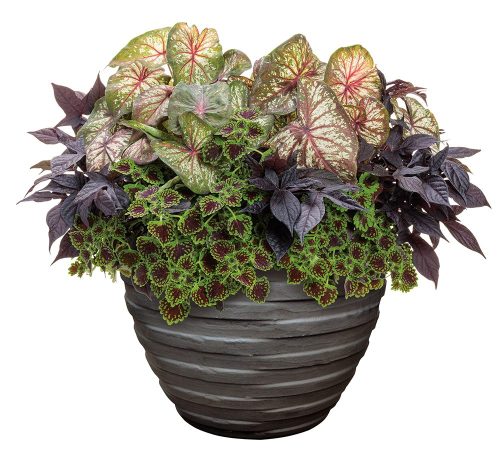
Growing Conditions: Full sun to part shade, average moisture, feeding every 2-3 weeks with water soluble fertilizer.
Plant List:
- Heart to Heart® ‘Xplosion’ caladium
- Sweet Caroline Raven™ sweet potato vine
- ColorBlaze® Chocolate Drop coleus
Why it works:
This low maintenance pairing features a trio of interesting foliage plants in a variety of leaf shapes, sizes, textures and plant habits. Complementary purple and deep red tones with a splash of white remain consistent all season with no need to sweep up spent blooms (because there aren’t any, of course!) Since foliage plants typically require less energy to flourish, feeding once every 2-3 weeks should be sufficient. This particular caladium variety tolerates both sun and shade, as do its companions, making this trio very versatile in the garden.
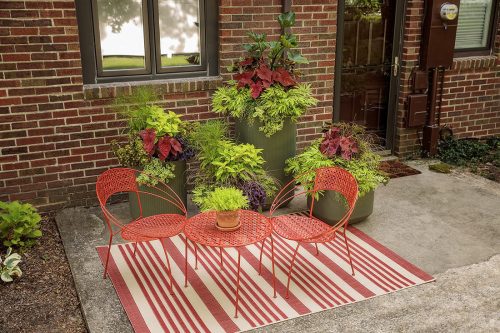
Growing Conditions: Full sun to part shade, average to moist soil, feeding every 2-3 weeks with water soluble fertilizer.
Plant List:
- Heart to Heart® ‘Burning Heart’ caladium
- ‘Coffee Cups’ elephant ears
- Graceful Grasses® Prince Tut™ papyrus
- ColorBlaze® Lime Time® coleus
- ColorBlaze® Strawberry Drop coleus
- Sweet Caroline Medusa™ Green sweet potato vine
- Plum Dandy™ Alternanthera
- Graceful Grasses® Fiber Optic Grass
- Graceful Grasses® Toffee Twist sedge
- Mezoo™ Trailing Red Aptenia
- Lemon Coral® sedum
Why it works:
This combo is a little different than the other plant combination ideas for container gardens listed above. Depending on the time of year, this back patio receives anywhere from four to seven hours of direct sun. By choosing plants that can grow well in both sun and part shade, we’ve ensured they will all flourish from spring to fall. Look closely at the plant mix here, taking special note of the variety of textures, shapes and sizes. Even though there are no flowers, this grouping feels like a lively, interesting scene, made even more electric by the addition of pops of red foliage and furniture.
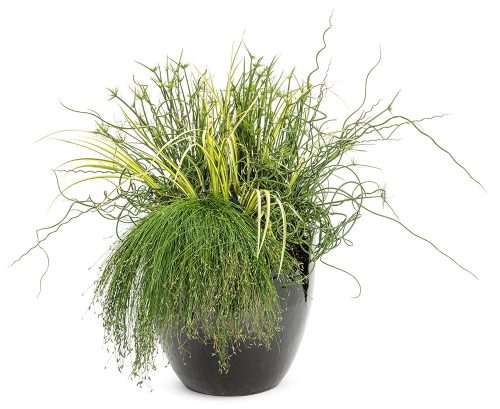
Growing Conditions: Full sun to part shade, moist to boggy soil, feeding once per month with water soluble fertilizer.
Plant List:
- Graceful Grasses® Queen Tut™ papyrus
- Graceful Grasses® Curly Wurly corkscrew rush
- Graceful Grasses® ‘Ogon’ sweet flag
- Graceful Grasses® Fiber Optic Grass
Why it works:
Do you have a container that doesn’t have a drainage hole in the bottom or a small pond? It can be tough to find plants that will tolerate wet or boggy soil, but these four ornamental grasslike plants all share a love for moisture – and lots of it! Each grows at a similar rate too, so one isn’t likely to dominate. Sometimes, you just need to think outside the box and try something different. We love the crazy shapes of these four grasses that unapologetically express themselves, adding a splash of whimsical fun to the garden.
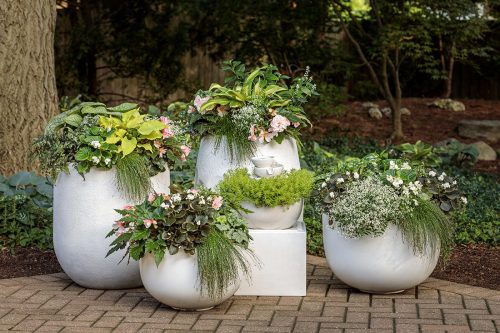
Growing Conditions: Part shade to full shade, average moisture, feeding every 2-3 weeks with water soluble fertilizer.
Plant List (most prominent plants):
- Double Delight® Blush Rose begonia
- Double Up™ White begonia
- Surefire® White begonia
- Diamond Snow® euphorbia
- Graceful Grasses® Fiber Optic Grass
- Lemon Coral® sedum
- Shadowland® ‘Echo the Sun’ and ‘Love Story’ hosta – zone 3-9 perennials
- ‘Jack of Diamonds’ brunnera – zone 3-8 perennial
- ‘Crested Surf’ Japanese painted fern – zone 4-9 perennial
- Dolce® ‘Spearmint’ coral bells – zone 4-9 perennial
Why it works:
An entire shade garden is captured in these five large containers that fill an east-facing nook that was previously underused. By including several perennials in the mix that can overwinter right in these containers in many zones, this homeowner is maximizing her container gardening budget. Pops of soft pink and white blooms as well as interesting foliage plants accent the perennials and can be changed out each year for an updated look.
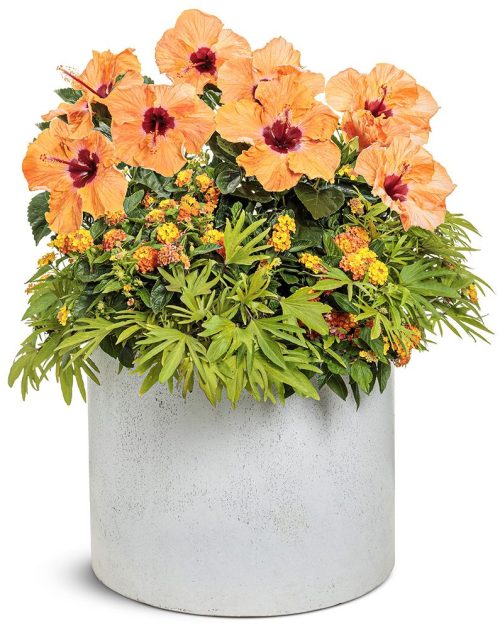
Growing Conditions: Full sun, average moisture, feeding every 3 weeks with water soluble, low phosphorous fertilizer.
Plant List:
- Hollywood Hibiscus™ Sunset Boulevard™ tropical hibiscus
- Luscious® Tangeglow® lantana
- Sweet Caroline Medusa™ Green sweet potato vine
Why it works:
Have you ever considered including shrubs in your container recipes? You could try a tropical type that can be brought indoors for winter like the Hollywood Hibiscus® pictured here, or a hardier shrub like an evergreen boxwood. Depending on the size of the shrub and pot, it may occupy most of the container so you would only need a few more plants to complete the look. Here, we chose a lantana whose blooms complement the everblooming flowers of the hibiscus along with a frilly textured sweet potato vine. Any two varieties of tropical hibiscus and lantana will do, so if orange isn’t your favorite, try pink or yellow varieties in the series instead.
We hope these plant combination ideas for container gardens inspired you!
Did you get to the bottom of this article and decide you’d rather purchase pre-planted container recipes? We have those too! Tap to shop, or see our DIY recipe kits.
All photos in this article are courtesy of Proven Winners®.
